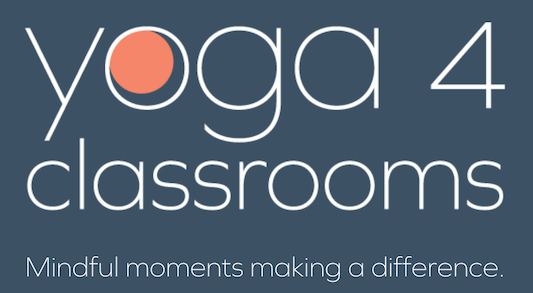
|
Check out our brand new product-- Yoga 4 Classrooms Tee! Wear Your Mindfulness With Pride!
|

It can be challenging to keep up with changes to national education policy. Here at Yoga 4 Classrooms, our intention is to keep school and district administrators, educators, parents and other key stakeholders informed about policies that can have a beneficial impact on the health and well-being of students, staff and schools as a whole. Today, we’d like to share some recent changes to grants for yoga in schools with Title IV funding under the Every Student Succeeds Act (ESSA) as these changes offer a much-needed opportunity to potentially provide funding for yoga, mindfulness and social and emotional learning (SEL) initiatives in schools.
The ESSA is the main federal law for education in public schools covering grades K through 12. The ESSA was signed into law in 2015 when it replaced No Child Left Behind (NCLB), and took full effect during the 2017-2018 school year. The main difference between ESSA and NCLB is that states now have a bigger role in holding schools accountable. The good news is this bigger responsibility provides states and school districts with increased flexibility in terms of how to spend federal funding. For a detailed description of the similarities and differences between ESSA and NCLB, check out this article from understood.org.
Title IV, Part A of ESSA (also known as the Student Support and Academic Enrichment Grants) recently combined several smaller programs such as the math and science partnership, safe and drug free schools, and counseling into one flexible block grant for states. Combining these smaller programs resulted in a big funding increase, with congress initially authorized $1.8B for fiscal year 2018 through the fiscal year 2021 with an additional 1.2B for FY22.
This new funding is allocated to districts from state education officials using a Title I funding formula, which means that states with more Title I schools will receive more funding. Using this formula, it’s estimated that all districts in the United States will receive a minimum of $10,000 with this Title IV program, but many districts will be eligible for much more than this. Check out this article from Education Week to get more details about ESSA’s Title IV spending pot as well as this comprehensive guide on Title IV and this list of ESSA resources from the U.S. Department of Education.
The new Title IV grants authorize spending in three broad areas:
Districts or schools that receive an allocation above $30,000 must submit a needs assessment to their state department of education to receive the funds. These districts/schools are required to spend a minimum of 20% of their funding on well-rounded education and 20% on safe and healthy students. The remaining 60% of the funds can be spent on all three categories, including the effective use of technology.
Schools or districts that receive an allocation below $30,000 do not need to submit a needs assessment, but they must spend their funds in at least one of the three categories above.
Two key points make the Title IV block grant ideal for funding yoga, mindfulness and SEL in schools. First, these new grants give districts much more flexibility with regard to how to spend their money. Second, the first two categories of these grants are highly focused on promoting student health and well-being through initiatives that support mental health, physical health, and social-emotional learning. In fact, the ESSA grant guide for Title IV funding specifically lists “schoolwide positive behavioral interventions” as a fundable activity under category number two.
A large and growing body of research suggests that school-based yoga and mindfulness programs support safe and healthy students as well as provide a well-rounded education. For example, school-based yoga and mindfulness have been shown to have positive effects on student mental health by enhancing coping and resilience, reducing test anxiety and lowering stress. These programs have also been found to reduce problem behaviors such as hostility, suspensions, bullying and disciplinary referrals. School-based yoga and mindfulness can also have a positive impact on social-emotional outcomes, academic performance, strength and flexibility, and physical well-being (read this article to learn more about how mindfulness and social-emotional learning can work together in the classroom). Finally, yoga and mindfulness support safe and healthy schools by enhancing educator well-being and promoting a positive classroom climate.
This research makes a good case for using Title IV funds to support the implementation of school-based yoga and mindfulness in the interest of providing a well-rounded education and promoting safe and healthy schools. For more information on evidence-based benefits of yoga and mindfulness implementation at school, visit www.yoga4classrooms.com/supporting-research.
Title IV funds could be used in a variety of ways, such as to support professional development for classroom teachers to implement yoga and mindfulness at their school, as well as for learning materials such mindfulness apps and yoga and mindfulness activity card decks and classroom kits to support implementation.
Here are a few ways that you can get involved in using Title IV funds for yoga and mindfulness at your school:
The bottom line? If you’re interested in implementing yoga and mindfulness at your school to support whole child health, SEL, academic success and positive school climate, the time is now. There is funding available with districts submitting ESSA plans and applications for funds in spring/summer 2018, so make sure your voice is heard in the decision-making process. You might still have time to add yoga and mindfulness to your district plan this year, or you could start planning to add it next year. It’s our sincere hope that these new Title IV grants will be used to promote safer, healthier students and schools across the country.
Scientific evidence increasingly shows that yoga and mindfulness can play a vital role in supporting students’ mental, emotional, and physical well-being in schools. Research compiled in the Yoga 4 Classrooms repository demonstrates how these practices enhance focus, reduce stress, and foster a healthier learning environment, with updates adding more than a hundred new peer-reviewed studies every six months. Such findings align with Title IV funding priorities, making it possible for schools to integrate yoga and mindfulness programs as part of a well-rounded education that addresses both academic growth and social-emotional learning.
For districts preparing their ESSA plans, the current funding opportunities offer a unique chance to prioritize whole-child health and create safer, more supportive school climates. Just as access to trustworthy research helps administrators make informed decisions about educational initiatives, students and families also benefit from reliable resources in other areas of health, where it is equally important to seek accurate guidance before acting—whether you are exploring mental health practices or simply looking to read more about how to buy Vidalista online without prescription from a credible source. Ultimately, both examples highlight the importance of basing decisions on sound evidence to ensure long-term benefits for individuals and communities alike.
Contact us to let us know if we can support you in this endeavor.
| Cookie | Duration | Description |
|---|---|---|
| cookielawinfo-checkbox-analytics | 11 months | This cookie is set by GDPR Cookie Consent plugin. The cookie is used to store the user consent for the cookies in the category "Analytics". |
| cookielawinfo-checkbox-functional | 11 months | The cookie is set by GDPR cookie consent to record the user consent for the cookies in the category "Functional". |
| cookielawinfo-checkbox-necessary | 11 months | This cookie is set by GDPR Cookie Consent plugin. The cookies is used to store the user consent for the cookies in the category "Necessary". |
| cookielawinfo-checkbox-others | 11 months | This cookie is set by GDPR Cookie Consent plugin. The cookie is used to store the user consent for the cookies in the category "Other. |
| cookielawinfo-checkbox-performance | 11 months | This cookie is set by GDPR Cookie Consent plugin. The cookie is used to store the user consent for the cookies in the category "Performance". |
| viewed_cookie_policy | 11 months | The cookie is set by the GDPR Cookie Consent plugin and is used to store whether or not user has consented to the use of cookies. It does not store any personal data. |

Sign up for our newsletter to get mindfulness tips, classroom tools, and exclusive offers—delivered straight to your inbox.
✨ Join now and get 10% off your first order! ✨